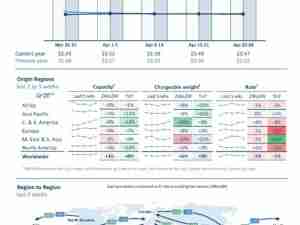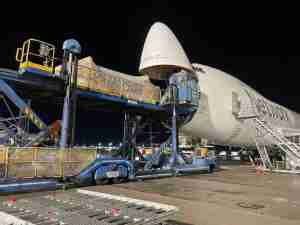The new chief financial officer of American Airlines Group Inc. has a message for skeptical voices in the credit community as the company seeks to secure a ratings upgrade: The $15 billion debt-cutting plan is on track.
After spending around $24 billion to upgrade its fleet in the run-up to the pandemic, following a bankruptcy and the merger with US Airways, the nation’s most-leveraged carrier is halfway through its biggest ever debt-reduction program.
Two months into the job, CFO Devon May is upbeat about the carrier’s ability to generate sufficient revenue through 2025 to raise its credit standing from B- to BB, in what would be the strongest rating since the merger about a decade ago.
High costs for labor and jet fuel — not to mention the threat of a severe recession — may yet throw a wrench into the plan. But with the US economy still firing on all cylinders, profits are returning to the business, helped by diminished capacity across the airline industry and higher fares.
“What you’re going to see from us over the next decade or so is just a more balanced approach to capital,” May said in an interview with Bloomberg News.
The company is signaling a new era of budgetary restraint is a priority, against the backdrop of higher interest rates, a $12 billion capital-expenditure program through 2027 and big debt payments on the horizon in 2025.
By the end of the year, American is aiming to bring a key leverage metric — net debt to earnings before interest, taxes, depreciation, amortization, and restructuring or rent costs — to the lowest since 2017. It also plans to pay down $2 billion to $3 billion in debt using free cash flow this year, according to May, 47.
“We’ll obviously have some just baseline level of growth that’s going to require some amount of capital expenditures, but you probably aren’t going to see the fluctuations like you saw pre-pandemic,” May said.
Airlines like American are benefiting from the post-pandemic recovery in demand for travel, especially among higher-end consumers. Yet, after the spending spree in the era of low interest rates, the debt-cutting mission now hinges on its ability to generate excess cash through a likely economic slowdown ahead.
“The big picture is, to continue to cut debt, they have to keep generating cash,” said George Ferguson, a senior airline analyst at Bloomberg Intelligence. “A lot of airlines left the pandemic with cash they can use to pay down debt. Some of the easy progress is behind them.”
Sweet Spot
The Fort Worth, Texas-based carrier ranks below peers like Delta Air Lines Inc., with the latter eyeing a boost to investment grade by 2024 from its current BB rating by S&P Global Ratings and BB+ from Fitch Ratings Inc. Meanwhile, Southwest Airlines Co. and Delta slashed total debt the most in 2022 compared to the year prior, with reductions of 23% and 11% respectively, according to data from S&P. American cut debt by around 5% on a comparable basis.
Still, the company’s debt largely trades in line with those peers, with its 7.25% bonds due February 2028 changing hands around 97 cents on the dollar, according to Trace data. Meanwhile significant debt maturities arise in 2025, when scheduled principal payments spike to $7.6 billion, according to Fitch.
A higher credit rating would give American the flexibility to better navigate the cyclical nature of its business and allow it to borrow at more attractive investment-grade levels for certain borrowings backed by its fleet and loyalty program, Treasurer Meghan Montana said.
“That’s the sweet spot we’re targeting, which was informed by our experiences during the pandemic and the level of market access we think we’ll be able to afford when we get to that point,” she said.
For now, airfares are largely going up more than costs, such as wages, but a shift in the economic and commodity cycle could yet endanger the effort, warns Helane Becker, an analyst at TD Cowen.
“The biggest concern is the recession is deeper and longer than people think it may be and spikes in fuel costs well over a hundred dollars per gallon would be hurtful,” she said. “Those are the two biggest things that would derail the plan.”
Still May is sanguine, citing now-modest capital outlays this year.
“The bookings we saw over the January period gave us a lot of confidence that our high-level demand forecast was a fair and accurate view of how this year could shape up,” May said. “If somehow our revenue projections are on the high end, I look at our capital-expenditure profile and we have a really nice one in a lower demand environment.”









